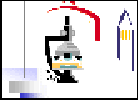
Contact Info
Adam P. Hitchcock
Canada Research Chair
in Materials Research
CLS-CCRS
B.I.M.R
McMaster University
Hamilton, ON
Canada L8S 4M1
V: +1 905 525-9140
x24729
F: +1 905 521-2773
E: aph@mcmaster.ca
U: unicorn.mcmaster.ca
__________
Research
Group
Opportunities
Publications
Links
_____________

|
|
Adam Leontowich
RESEARCH: Chemical lithography and fundamentals of X-ray damage to polymers
- Is the amount of radiation damage to organic solids (i.e. polymers) proportional to the total absorbed dose, independent of wavelength?
- In terms of achieving the smallest possible feature size in photo-lithography, is there an optimal energy at which to pattern resists?
- What advantages (if any) does a focused soft X-ray beam system have over conventional, compact, commercially available, and relatively inexpensive focused electron beam systems for nanofabrication?
My main experimental tool to tackle these questions is soft X-ray scanning transmission X-ray microscopy (STXM). When a sample is subjected to the intense soft X-rays of the STXM, the amount of energy absorbed by the irradiated area is often enough to cause extensive chemical (bond formation or bond breakage) and physical (mass loss, morphology, carbon contamination) changes. On one hand, the rapid degradation of sensitive samples is undesirable for spectromicroscopic investigations as the images and X-ray absorption spectra collected may not be representative of the true virgin sample. On the other hand, radiation-induced changes, such as the main chain scission of poly(methyl methacrylate), are useful and relevant for patterning and photolithography. These processes are the root of the industrial scale fabrication of microprocessors. My research centers around investigating the many qualitative and quantitative effects of soft X-rays on materials (primarily polymers, many are resist type materials). We work towards a better understanding of fundamental aspects of radiation physics and chemistry, and then apply this knowledge, for example, to optimize NEXAFS data acquisition, and to advance applications of chemically selective sub-100 nm patterning.
I feel very fortunate to have access to, and to be able to operate independently, three of the most advanced STXMs in the world:
Beamlines 5.3.2.2
and 11.0.2
at the Advanced Light Source, Berkeley,
California, USA
Beamline 10ID-1
(SM) at the Canadian Light Source,
Saskatoon, Saskatchewan, Canada
and to work alongside some of the most knowledgeable minds in X-ray spectromicroscopy.
At McMaster, I use the JEOL 7000F scanning electron microscope
at the Canadian Centre for Electron
Microscopy.
Our own lab has a very capable Quesant 350 atomic force microscope, as well as excellent sample preparation facilities (spin coater, vacuum annealer, etc).
|
|
© 2010 A.P. Hitchcock / McMaster University
- All Rights Reserved
web site by Christopher Amis. Last updated on 10-Nov-2011 (aph)

